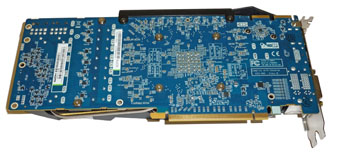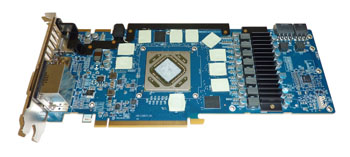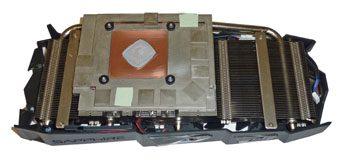Introduction
AMD's premium Radeon HD 7000-series graphics cards weren't quite ready for prime-time action when released at the turn of the year, especially when put up against NVIDIA's equivalent GeForce 600-class GPUs. AMD's perhaps realised this and has gone about improving the value proposition offered by its best graphics cards through a combination of severe price cuts and general gaming optimisations through recent drivers.
A case in point is the Radeon HD 7950, which debuted in January for £350. Now readily available for under £250 and made that much more attractive via a 'three-for-free' gaming promotion via selected retailers, together with the promise of a higher core frequency through a user-upgradable BIOS, it's time to revisit AMD's second-best GPU.
Sapphire's decided that HD 7950's allure can be maximised through the launch of yet another custom-cooled card. The HD 7950 OC Vapor-X, pictured above, is the newest member of the pre-overclocked Sapphire clan, and it is the only one imbued with frequency-hopping technology that goes by the name of PowerTune with Boost (PTWB), first seen on the AMD HD 7970 GHz Edition. Put simply, PTWB dynamically increases frequency and voltage if there's scope to do so, usually in concert with higher TDPs auto-enabled by software settings within Catalyst Control Center.
This here Sapphire HD 7950 nominally clocks in at 850MHz core and 5,000MHz memory, representing a core uptick that's just 50MHz higher than default. Press the Sapphire 'Lethal Boost' button found on the side of the card and PTWB kicks in, offering a core speed up to 950MHz, which is 25MHz above AMD's own recommendation. This extra frequency is a one-step jump - the card either runs at 850MHz or 950MHz, and not anywhere in-between. Memory speed remains a default 5,000MHz, however.
Increasing available power and frequency puts a strain on the card's cooling. Sapphire's built this particular HD 7950 with overclocking very much in mind and thus equipped it with the same type of Vapor-X cooler found on the HD 7970 OC variant. It's big, meaty and sufficiently capable of keeping a sky-high-clocked HD 7950 cool and quiet, according to previous findings.
A couple of 90mm fans sit quite high on the heatsink - they're actually higher than the dual-slot backplate - and the heatsink takes up the entire 10.5in of the PCB, while the 8+6-pin plug arrangement is pregnant with additional voltage and power promise. For those with a penchant for aesthetics, the Sapphire logo is lit by a white LED and the 'Lethal Boost' button glows blue.
Though the card is non-standard in appearance, the rear outputs follow AMD's lead, comprising of single-link DVI, dual-link DVI, HDMI and DisplayPort. It's worth noting that the Vapor-X isn't equipped with Sapphire's output-enhancing FleX technology, where the usual trio of dual-DVI and HDMI can all be concurrently used to power three monitors. Rather, connecting three screens requires using the DisplayPort connector that, for most, will necessitate the additional purchase of an active adapter.
Laid bare and Sapphire's handiwork comes into view. Sensibly placing thermal pads between cooler and memory while also adding a heatsink for the hot-under-the-collar VRM components, Sapphire understands how to design a premium Radeon card. The four-heatpipe cooler's base plate juts out from the heatsink enough to give the VRM heatsink adequate clearance, and overall cooling is aided by the downward-firing airflow produced by the two fans.
Packaged up with all the gubbins you'll need to get it operation, including a decent HDMI cable, Sapphire's cards are backed up by an industry-standard two-year warranty. There's no active, DAC-equipped DP-to-DVI adapter, mind, so folks contemplating running older screens will need to shell out a few more notes.
Sapphire says it's looking at a street price of some £260 for this model, putting it firmly - and intentionally, most likely - in the crosshairs of the recently-released GeForce GTX 660 Ti from NVIDIA. We'll let battle commence and see if a mildly-overclocked HD 7950 has enough chutzpah to take on NVIDIA's latest Kepler card.















